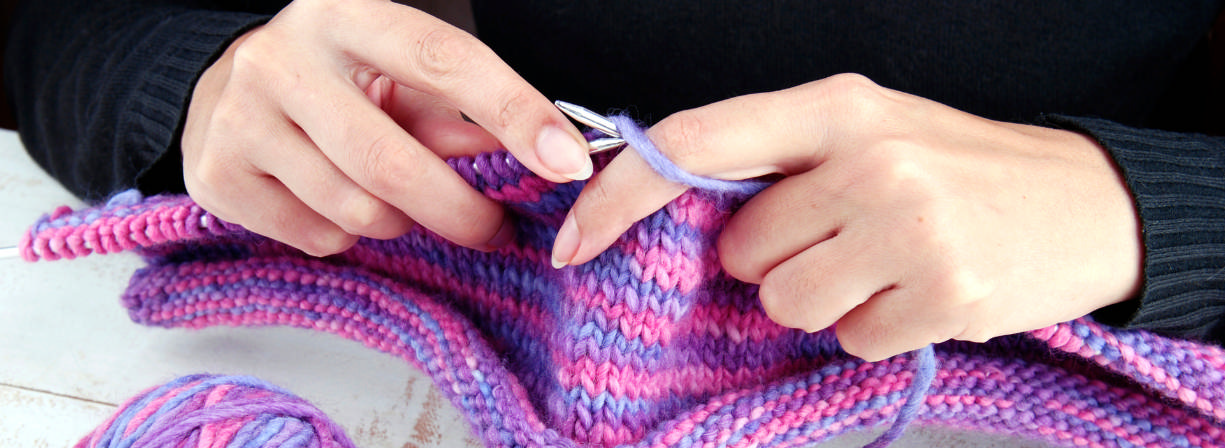Knitting has a long and fascinating history that originated in the Middle East and eastern Mediterranean around the 11th or 12th century. The earliest knitted artifacts are Egyptian socks from that era. Knitting then spread to Europe, where male guilds used it to make religious garments. Gradually, it became an ubiquitous and critical aspect of daily life, practiced by people of all genders and cultural backgrounds, and cherished as a means of providing warmth and comfort through hand-crafted clothing and blankets. Over time, knitting was passed down from generation to generation and evolved to reflect the unique cultural influences of various regions.
Before knitting, there was a needlework technique known as Nålbinding, (a Norwegian word meaning “needle binding”). Nålbinding creates a fabric similar to knitting by looping and knotting yarn with a single needle. It is often associated with the Vikings, but it was also practiced in other parts of the world. Archaeologists have found nålbinding fragments dating from various periods, such as 10,000 years ago in Israel, 7,750 BCE in Germany, the 5th or 6th century CE in Egypt, and the 9th or 10th century CE in Norway.
Another precursor to knitting was finger knitting, which is a simple form of knitting done using only the fingers instead of needles. Finger knitting has been practiced for centuries, especially by children and those who did not have access to needles.
These early forms of needlework laid the foundation for the development of knitting as it is known today.
Over time, knitting spread throughout the world and became popular in Europe, particularly in Scandinavian countries (close to our hearts, naturally), where it was used to create intricate patterns for clothing, blankets, and other household items.
The use of high-capacity knitting machines during the Industrial Revolution did make it easier to produce large quantities of knitwear. (Fun fact: knitting machines were first used in the late 1500s.) However, hand-knitting persisted as a beloved and widely-practiced craft, enjoyed by people from all walks of life. The rise of online communities such as Ravelry and social media platforms like Instagram and Facebook has facilitated greater connection and exchange between knitters, making it easier for them to share patterns and be inspired by one another.
The benefits of knitting
Knitting offers a wide range of benefits to individuals and society. On a personal level, knitting can help reduce stress and anxiety by focusing on the present. It enhances cognitive function by stimulating various areas of the brain, including the motor cortex, frontal lobe, and occipital lobe. It’s also a great way to stay active and improve hand-eye coordination, especially for older individuals. It can also slow down cognitive impairment and Alzheimer’s disease.
Knitting is obviously a great creative outlet for self-expression, can provide a sense of accomplishment, and can boost one’s self-esteem, as well as being a fun hobby that can be done alone or with a group.
From a societal perspective, knitting is a great way to bring people together and promote community building. Knitting groups are a popular way for people to socialize and form new connections while enjoying a shared hobby. Additionally, the popularity of knitting has helped revive traditional crafts and techniques, preserving cultural heritage and promoting cultural appreciation. Finally, knitting can also be a form of charity work, with many knitters using their skills to create items for those in need, such as blankets for children, scarves for the homeless, and hats for soldiers.
For society, knitting is a sustainable and eco-friendly pastime, as it empowers individuals to make their own garments, accessories, and home goods, thereby reducing their dependence on mass-produced, synthetic goods, which can have adverse effects on the environment.
Knitting has been and continues to be an important part of many cultures and traditions, and it’s a craft that has stood the test of time, evolving and adapting to changing needs and styles over the centuries.
Looking for inspiration for your next knitting project, check out these patterns!
PS. If you’re new to knitting, you might also like our tips for new knitters.
Want to learn more about knitting’s cousin, Crochet? Click here.



This was really helpful for my school project on the history of knitting, I had no idea where to look so I was relieved to find your website.